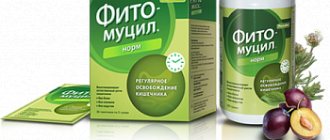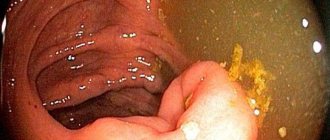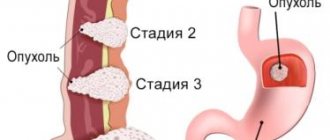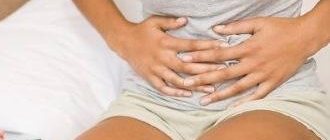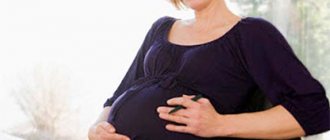Causes of spastic constipation
If atonic constipation occurs due to a decrease in the tone of the intestinal walls, then spastic constipation is due to its increase, which leads to spasm of certain areas of the muscles. That is, feces do not move through the intestines due to a mechanical obstruction.
Possible causes and risk factors for increased muscle tone:
- eating disorder;
- poor nutrition (fiber deficiency, excess spicy foods and excessive consumption of protein foods);
- bad habits;
- sedentary lifestyle;
- high psychological and nervous stress;
- pregnancy;
- taking certain medications;
- chronic intoxication of the body.
Spastic constipation in a child can occur when introducing a new food into complementary foods, switching to artificial feeding, insufficient drinking regimen, or excessive consumption of sweets. In some cases, the reason is a psychological factor - a change of school or place of residence, etc.
Sometimes spastic constipation is a consequence of diseases of the endocrine system, neurovegetative diseases, metabolic and hormonal disorders.
Bibliography
- Minushkin O.N. Chronic constipation (definition, epidemiology, diagnosis): Modern drug therapy. Medical Council 2015 | No. 13.
- Tumarenko A.V., Skvortsov V.V. Modern approaches to pharmacotherapy of constipation. Medicinal Bulletin No. 2 (66). 2022.
- Instructions for use of the drug MICROLAX® // Registration number N011146/01 // RF GRLS. – URL: https://grls.rosminzdrav.ru/Grls_View_v2.aspx?routingGuid=f052fb31-5426-4bc1-958f-9fce793aa43f&t=(access date: 01/20/2020)
- Parfenov A.I., Indeikina L.H., Belyaeva A.A. Chronic constipation. Guidelines. Moscow 2016, 54 p. URL: https://www.gastroscan.ru/literature/pdf/parfenov-ai-gr.zap.pdf
- Adil E. Bharucha, A. Wald. Chronic Constipation. Mayo Clin Proc. 2019; 94(11): 2340-2357.
- Pathophysiology: textbook: in 2 volumes / ed. V.V. Novitsky, E.D. Goldberg, O.I. Urazova. — 4th ed., revised. and additional - GEOTAR-Media, 2009. - T. 2. - 640 p.
- World Gastroenterology Organisation. Constipation: a global perspective. WGO Global Guidelines. 2010.
- Vyalov S.S. Chronic constipation: etiology and treatment options // Doctor.Ru. Gastroenterology. 2015. No. 12 (113). pp. 42–49. — URL: https://journaldoctor.ru/upload/iblock/4f9/Doctor.Ru_Gastroenterology_No_12(113)_2015_8.pd
- Association of General Practitioners (Family Doctors) of the Russian Federation. Clinical guidelines for general practitioners: constipation syndrome. 2014
- Bulatov V.P. et al. Modern recommendations for the management of children with functional constipation. Russian Bulletin of Perinatology and Pediatrics, 5, 2015.
- Zakharova I.N. Functional constipation in children // Breast cancer. Mother and child (Pediatrics). 2009. No. 15. pp. 988–996. — URL: https://www.gastroscan.ru/literature/authors/7936
- Studenikin V.M. Constipation in children: a neurologist's view. Lying doctor No. 01 - 2022. - URL: https://www.lvrach.ru/2019/01/15437184
- Nikolaeva S.V., Gorelov A.V. Treatment and prevention of functional constipation in children // Difficult patient. 2022. No. 1-2. — URL: https://cyberleninka.ru/article/n/lechenie-i-profilaktika-funktsionalnyh-zaporov-u-detey (access date: 01/23/2021).
- Fayzullina R.A., Belmer S.V. Chronic constipation in pediatric practice: what do we know? What's new? Experimental and clinical gastroenterology. 2019;171(11): 16–26.
- Russian Gastroenterological Association and Association of Coloproctologists of Russia. Clinical recommendations: Constipation. 2022.
- Shcherbakov P.L. Intestinal colic in infants. Differential diagnosis and approaches to therapy. Medical advice. 2014;(14):67-71. https://doi.org/10.21518/2079-701X-2014-14-67-71
- Gubergrits N.B., Belyaeva N.V., Agibalov A.N. IBS: effective treatment regardless of the change of scenery. Gastroenterology: doctor's notes, 2013.
- Roytberg G.E., Strutynsky A.V. Internal illnesses. Digestive system. Textbook: M. - Medpress-inform, 2007.
- Surgical diseases: Textbook / M. I. Kuzin, O. S. Shkrob, N. M. Kuzin, etc.; Ed. M.I. Kuzina. — 3rd ed., revised. and additional - M.: Medicine, 2002. - 784 p.
- Functional intestinal disorders in children [Text]: study. allowance / L. E. Safronova, G. V. Fedotova, I. V. Vakhlova. - Ekaterinburg: Publishing house of USMU, 2016. - 64 p.
Watch a review of laxatives in the video from MICROLAX®!
Symptoms of spastic constipation
The main manifestation of the disease is stool retention (decreased urge). Depending on the delay period, there are:
- Compensation stage - the intestines empty every 2-3 days.
- Subcompensation stage - defecation occurs every 3-5 days.
- Stage of decompensation - defecation occurs less than once every 5 days.
Other signs of spastic constipation:
- bloating;
- unpleasant taste in the mouth;
- belching;
- feeling of fullness in the lower abdomen and/or acute pain;
- feeling of insufficient bowel movements after going to the toilet;
- hard, lumpy stools;
- small amount of feces.
Rare bowel movements lead to intoxication of the body, which is accompanied by fatigue, sleep disorders, lack of appetite, irritability, and headaches. The skin loses its elasticity and acquires a yellowish tint.
Diagnostics
The doctor makes a preliminary diagnosis based on the patient’s complaints. For the final conclusion, an examination, colonoscopy, and anorectal manometry are performed. If necessary, sigmoidoscopy, fibrocolonoscopy, abdominal radiography, irrigoscopy, electromyography of the pelvic muscles, ultrasound of the intestines, stomach, liver and pancreas, and enterocolonoscintigraphy are prescribed.
Laboratory tests require blood tests, coprogram, stool analysis for helminths and dysbacteriosis.
A differential diagnosis of spastic constipation with intestinal obstruction, anomalies and tumors of the large intestine, Crohn's disease, and diverticular disease is also carried out.
Treatment of spastic constipation
First of all, the patient’s diet and diet are adjusted, so a special diet with low dietary fiber and high fiber content is mandatory. It is preferable to eat food warm. You should not overeat (the daily amount should be divided into 5-6 small portions) and eat dry. It is necessary to minimize the consumption of sugar and salt.
Recommended products: boiled fish and meat, low-fat broths, vegetables, fruits, curdled milk, natural yogurt and kefir, dried fruits (especially prunes), durum wheat pasta, wholemeal bread, almonds, freshly squeezed juices, herbal tea, compotes from dried fruits, biscuits.
Prohibited foods: fatty meats, legumes, cabbage, spinach, sorrel, garlic, onions, mushrooms, apple and grape juices, bananas, citrus fruits, milk, pickles, smoked meats, sausages, sweets, chocolate, fresh bread, carbonated and alcoholic drinks .
If there are no contraindications, you should drink 1.5–2 liters of water per day. Non-carbonated mineral waters are useful for patients with constipation.
Antispasmodic drugs for spastic constipation - Drotaverine, Spasmol, Papaverine - are used to relieve spasms and eliminate pain.
For gentle cleansing of the intestines, an osmotic laxative based on lactulose is used for spastic constipation: Duphalac, Goodluck, Normaze, Prelax. You can also use drugs in the form of microenemas (Microlax, Enema Klin, Enemaksal), rectal suppositories (Glycerin, Glycelax) or oils for oral administration (vaseline oil, almond oil).
In some cases, it is recommended to carry out cleansing enemas with the introduction of warm herbal decoctions.
If constipation is not functional, but psycho-emotional in nature, the prescription of a sedative for spastic constipation is required.
Publications in the media
Constipation (constipation, obstipation) is difficulty in emptying the colon (colostasis) or rectum (coprostasis). • Constipation is characterized by the following symptoms •• decreased frequency of stool less than 3 times per week •• denser stool consistency (“sheep feces”) •• passage of a small amount of feces (less than 100 g) •• feeling of incomplete bowel movement after bowel movement •• prolonged or a multi-stage act of defecation, the implementation of which requires additional straining efforts or the use of special techniques and postures (straining time is more than 25% of the time of the act of defecation) • Normally, food taken within 8 hours after defecation is evacuated over the next 24 hours • Constipation may be a random episode (episodic or situational constipation) under temporary unfavorable conditions •• Long travel, the need to use an inadequate toilet •• Significant physical activity •• Steam bath •• Pregnancy •• Consumption of certain products (tea, cocoa, low content of ballast substances in food) •• Emotional factors (mental overload, depression) •• Iatrogenic constipation.
Frequency. Constipation occurs in 1–6% of healthy people, more often among children, and in people over 60 years of age, especially with a sedentary lifestyle, the incidence of the disease reaches 80%.
Etiology • Primary constipation (with intestinal diseases) •• Functional (habitual) constipation ••• Rectal constipation - disappearance or absence of the defecation reflex ••• Cologenic constipation - slowing of the intestinal passage of chyme as a manifestation of dyskinetic disorders ••• Dyssynergia of the pelvic floor muscles - disorder evacuation of feces associated with the lack of adequate relaxation of the anal sphincters and/or puborectal muscle loop during defecation •• Organic constipation (colitis, colon strictures, cancer and benign tumors, dolichosigma, idiopathic megacolon, etc.), as well as diseases rectum, accompanied by a pain syndrome that inhibits the urge to defecate (acute or chronic anal fissure, cryptitis, internal incomplete fistula of the rectum, hemorrhoids) • Secondary constipation is associated with extraintestinal diseases •• Reflex (with peptic ulcer, cholecystitis, nephrolithiasis, etc. ) •• Endocrine (myxedema, diabetes, hypercalcemia, etc.) •• Metabolic and toxic (lead poisoning, prescription of anticholinergics, ganglion blockers, iron supplements, diuretics, sedatives, etc.) •• Neurogenic (parkinsonism, spinal cord diseases, etc. ) •• Muscular diseases: myopathies, scleroderma and other diseases with damage to the muscles (diaphragm, abdominal wall) involved in the passage of feces and the act of defecation •• Psychogenic (psychopathy, schizophrenia, etc.) • Other causes: diet low in plant fiber combined with decreased fluid intake and insufficient physical activity, as well as frequent holding in bowel movements (the most common cause).
Genetic aspects - see Hirschsprung's disease.
Risk factors • Poor nutrition • Uncontrolled use of laxatives • Gastrointestinal diseases • Pathological processes in the anus and rectum • Disorders of nervous and endocrine regulation • Physical inactivity • Change of place of residence • Hereditary predisposition.
Clinical picture • Absence of stool for several days or weeks. In case of prolonged absence of stool, intestinal obstruction may occur • Local (abdominal) signs •• Feeling of pressure, distension in the rectum, its incomplete emptying after defecation (with rectal constipation); migrating pain, transfusion; rumbling in the abdomen and bloating (with colonic constipation) •• Hemorrhoids, papillitis, fissures and ulcerations of the anus due to damage by hard and copious feces •• Palpation of the abdomen - dilated and spastically contracted areas of the colon, in which it is often possible to detect dense feces masses, most often in the descending colon and sigmoid colon •• During digital examination of the rectum, fecal stones may be detected • Reflex symptoms •• Pain in the buttocks, sacrum, thighs, which arise due to the pressure of fecal masses on the sacral nerve roots •• Headache , dizziness, tachycardia, disappearing after defecation • General manifestations - weakness, malaise, loss of appetite, unpleasant taste in the mouth, coated tongue, nausea, low-grade body temperature, etc. The occurrence of these signs is explained by the toxic effect of indole, cresol and other metabolites, the formation and absorption of which in the intestine is increased during constipation.
Laboratory tests • Leukocytosis up to 15´109/l • Hyponatremia • Hypokalemia • IDA • Coprological examination: admixture of blood and mucus (for malignant neoplasms, Crohn's disease) • Study of intestinal microflora.
Special studies • Digital examination of the anus and rectum allows you to determine the tone of the external sphincter of the anus, tumors in areas of the rectal ampulla inaccessible to endoscopic instruments (immediately behind the anal canal) • Colonoscopy allows you to diagnose malignant tumors, polyps, various inflammatory changes • Irrigography helps identify the etiological factor, determine the localization of stagnation of contents in the colon, quantitatively assess the evacuation function of the colon • Evacuation defecoproctography is used for direct visualization of the act of defecation and assessment of the state of the pelvic floor • Anal manometry and profilometry record pressure levels in the anal canal at rest and during various functional tests .
TREATMENT
Diet. Regular meals (at least 3-4 times a day), at the same time. Sufficient (at least 1.5 liters per day) fluid intake, including soups, juices, mineral waters, dairy products. They recommend products that improve peristalsis (brown bread, raw vegetables and fruits, dried fruits, legumes, oatmeal, buckwheat, meat, pickles, marinades, drinks saturated with carbon dioxide, fermented milk drinks). For colitis, laxatives are given in quantities that do not cause exacerbation of the disease. In case of duodenal ulcer during an exacerbation, diet No. 1 is prescribed with an increased amount of substances that enhance peristalsis from among those allowed.
Management tactics • Regulation of the act of defecation (daily at the same time) • It is necessary to identify the etiology of constipation •• Treatment of symptomatic constipation - therapy of the underlying disease •• With independent (functional constipation), often caused by insufficient consumption of essential foods (deficiency of salts, vitamins , plant fiber) or liquid, as well as poor diet and decreased physical activity, good results are achieved using a corrective diet and exercise therapy •• Treatment of simple constipation (the result of slow movement of intestinal contents) is aimed at stimulating the intestines by increasing the content of fibrous components in the diet (for example, fruits, vegetables and swelling agents - hydrophilic colloids that retain water and electrolytes in the intestinal lumen) • Long-term use of strong laxatives should be avoided, because. they can lead to dysfunction of the intramural nerve plexuses of the colon.
Conservative treatment • Group I drugs - chemical laxatives. They cause a laxative effect by irritating the receptor apparatus of the colon and, thus, stimulating its peristalsis. Causes a single bowel movement 6–10 hours after ingestion. Drugs in this group include derivatives of anthraquines (preparations of senna, buckthorn, rhubarb), diphenylmethane (phenolphthalein, bisacodyl, sodium picosulfate), castor oil • Drugs of group II are osmotic laxatives that have the ability to retain water in the intestinal lumen, which leads to an increase in volume and softening of feces. Preparations in this group include sodium and magnesium sulfate, magnesium hydroxide, Carlsbad salt, and the non-adsorbable polysaccharide lactulose. They act at the level of the colon, the onset of laxative effect is 8–12 hours • Group III drugs - bulk laxatives or fillers help increase the volume of intestinal contents (bran, agar-agar, methylcellulose, seaweed, etc.) • Group IV drugs - laxatives oils (detergents) help soften hard feces and facilitate their sliding - petroleum jelly, almond oil, fennel oil, liquid paraffin. The laxative effect after taking them occurs within 4-5 hours • For constipation associated with impaired intestinal motor function, prokinetics are prescribed (cisapride 10 mg 3-4 times / day, trimebutine 100-200 mg 3 times / day), in the presence of a pronounced spastic component - myotropic antispasmodics (drotaverine, papaverine hydrochloride, bencyclane), calcium channel blockers: mebeverine 200 mg 2 times / day, pinaverium bromide 50 mg 3 times / day.
Surgical treatment is indicated when an organic cause of constipation is identified (tumor or stricture of the intestine, megadolichosigma) or the development of surgical complications (acute intestinal obstruction, intestinal perforation, peritonitis).
Prevention • Compliance with nutrition and diet • Active lifestyle • Physical education • Restoring the urge to defecate - going to the toilet at the same hours.
Complications • Acute intestinal obstruction • Volvulus • Abdominal wall hernia • Colon diverticulosis • Ulceration of the colon mucosa • Perforation of the intestinal wall • Rectal prolapse • Anemia.
Course and prognosis • Relapses are typical • With the development of surgical complications (perforation and peritonitis), the prognosis is unfavorable • Mortality with intestinal obstruction is high in infants and the elderly (more than 16%).
ICD-10 • K59.0 Constipation • K56.4 Other type of closure of the intestinal lumen
Frequently asked questions about constipation
How do I know if I'm constipated?
Ideally, you should have a bowel movement every day. Having bowel movements less than 3 times a week in most cases indicates a problem. If you have to strain (push) when going to the toilet, and afterward there is no feeling of complete emptying, you should consult a doctor.
How to determine atonic or spastic constipation?
These constipations differ in different development mechanisms. With atonic constipation, the bowel movements are profuse, sausage-shaped, and the process of defecation is very painful. With spastic constipation, the stool is fragmented (individual hard lumps), defecation is not painful, but patients experience acute colicky pain in the abdomen.
Clinical medical approaches to treatment
Often the problem is solved with drug therapy. For this, patients are prescribed laxatives and stimulants of intestinal muscle activity. Laxatives are good only for one-time use, but their effect is not always predictable over time. Therefore, using the tools of this group, you have to calculate your day literally by the minute. For people who lead an active lifestyle, laxatives are not the best choice.
Stimulants help the intestinal muscles push the bolus of stool through the cramped areas. There are a huge number of drugs that can be used to confidently control bowel movements.
However, drugs from both described groups have serious disadvantages: • Long-term use is addictive. Therefore, there is a need to constantly increase the single dosage of the drug for constipation. If at first 1 tablet is enough, then after a few months the body will need 5-6.
• Constipation medications are not harmless. Long-term use causes changes in the muscular lining of the intestinal walls - the walls partially lose their elasticity, become rougher and even change color.
In addition, taking laxative medications in itself can provoke the development of constipation.
Unlike traditional medicine, where each patient is prescribed the same laxatives, osteopathy approaches the body individually. For organic constipations, osteopathy complements clinical medicine by identifying mechanical obstructions in the intestines.

